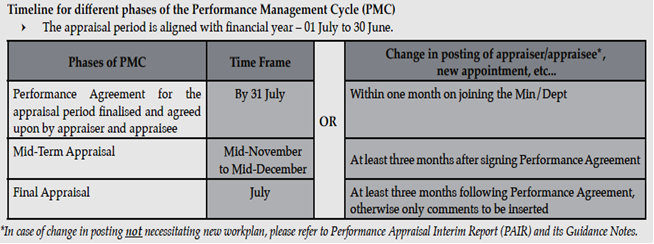Performance Management System
Page Content
1. What is Performance Management System (PMS)?
PMS is a management tool for good governance and improved performance, providing the opportunities to identify the development needs
of employees at all levels in the organization. It is an important and integrated reform strategy whereby better results are obtained from the
organization, teams and individuals by understanding and managing performance within an agreed framework of planned goals, objectives,
standards and competencies
2. What is a Performance Management Cycle (PMC)?
It is a continuous cycle of 12-months, aligned with the financial year (01 July – 30 June) during which the organisation, section/unit and individual
performance is planned, monitored and assessed.
Note: For more details, please refer to Booklet on “Understanding Performance Appraisal Forms and Performance Improvement Plans".
3. What are the different types of Performance Management System (PMS) Forms?
(i) Executive Performance Management Review (Supervising Officer)
This form is filled in by Supervising Officers (SOs) in charge of Ministries, Divisions and Departments (including all Permanent Secretaries).
(ii) Performance Appraisal Form (Senior Management)
This form is filled in by all Heads of Divisions/Departments, excluding Supervising Officers, drawing salary in a scale with maximum point not less than Rs 83,000 (PRB Report 2016).
(iii) Performance Appraisal Form (General)
This form is filled in by all grades, except those falling under (a) and (b) below:
(a) Heads of Divisions/Departments drawing salary in a scale with maximum point not less than Rs 83,000 (PRB Report 2016) and Supervising
Officers.
(b) Workmen's Group.
(iv) Performance Appraisal Form (Workmen's Group)
This form is filled in by employees in the Workmen's Group.
(v) Performance Appraisal Interim Report (PAIR)
This form is applicable to all grades filling in Performance Appraisal Form. It is filled in all cases of change in posting of either Appraiser or
Appraisee during the course of the Performance Management Cycle, where the Appraisee's work plan remains the same.
(vi) Performance Improvement Plan (PIP)
This form is filled when:
a) an Appraiser considers that the Appraisee's current performance requires improvement after discussion with the latter. This may take place
at any time during the Performance Management Cycle; and
b) the Appraisee's overall performance rating is below 2.40. The PIP is developed and monitored during the next Performance Management Cycle.
PIP form has been developed for employees falling under the following categories:
Senior Management and
General Workmen's Group
(vii) Performance Management Appeal Form
This form is filled in case there is an Appeal Process.
Note: For more details, you may refer to “Guidance Notes" on the last page of respective forms.
4. Why is it important to fill Performance Appraisal Form (PAF)?
The PAF is a document to record an employee's performance during a Performance Management Cycle (PMC). It is used for various
purposes including, but not limited to:
(i) Identification of training needs
The PMS is an invaluable source of information on training needs of officers at all levels and provides useful inputs for mapping out
systematic training plans for all Ministries/Departments.
(ii) Appointment and promotion purposed
As from January 2013, and in accordance with Regulation 18 of the Public Service Commission (PSC), the Reporting System to the
Commission comprises:
(a) the Performance Appraisal Report on the officer/s concerned, i.e. the appraisal form being used in the context of the PMS; and
(b) a Report on fitness for promotion on each officer concerned.
(iii) Grant of annual increment
The annual increment is a variable component which is based on overall performance and has to be earned.
At paragraph 18.9.1, Volume 1 of the PRB Report 2016, it is stipulated that
“Increment on a salary scale is not as of right" and at paragraph 8.9 of the same Report, the PRB recommended, inter alia, that:
“(a) annual salary increments should only be awarded taking into consideration efficiency, diligence, commitment including
availability and regularity of officer at work based on open and recorded performance assessment ratings;"
5. What does a Performance Agreement (PA) consist of?
It encompasses a work plan of duties performed and competencies to be displayed during a Performance Management Cycle,
except the PA of employees in the Workmen's Group which consists of competencies only.
6. What is a work plan?
A work plan is part of the Performance Agreement.
It is the written outline of Key Result Areas, Key Tasks and Performance Standards identified and developed in respect of duties to
be performed during a Performance Management Cycle
Note: Employees in
the Workmen’s Group do not have to develop a work plan.
7. Who should fill in the Performance Appraisal Form?
All employees in the Civil Service falling under the category of Senior Management, General and Workmen's Group, including those:
(i) appointed in a temporary capacity or on probation;
(ii) drawing top/flat salary;
(iii) due to proceed on retirement;
(iv) serving on tour of service in Rodrigues, Agalega, St Brandon etc;
(v) proceeding on leave or resuming duty after leave e.g. vacation, maternity, as applicable;
(vi) in the process of restructuring their Ministry/Department; and posted in Consulates, Diplomatic Missions, High Commissions and Embassies abroad.
8. What if the Appraiser/Appraisee gets a change in posting during a Performance Management Cycle (PMC)?
A. In case the Appraisee's work plan does not necessitate any modification:
No need to close the current Performance Appraisal Form (PAF).
Performance Appraisal Interim Report (PAIR) is filled.
The PAIR should be attached with the relevant PAF for the Performance Management Cycle.
B. In case the Appraisee's work plan necessitates modification:
The current PAF is closed, another PAF is opened.
Note: For more details,
please refer to “Guidance Notes of PAIR”.
9. What are the steps to be followed if an Appraiser and/or an Appraisee disagree at any stage during a Performance
Management Cycle (PMC)?
(i) Appraiser and Appraisee discuss the issue and try to resolve the divergence at their own level;
(ii) where no agreement is reached, the Appraiser or the Appraisee seeks the intervention of the Next Level Supervisor (NLS); and
(iii) the process of Conflict Resolution at Figure 1 on Page 3 of the Booklet on “Moderation and Appeal Processes" is then followed.
Note: For more details,
please refer to Booklet on “Moderation and Appeal Processes”.
10. What are the steps to be followed if an Appraisee is dissatisfied with the ratings/comments at the final appraisal exercise?
(i) Appraiser and Appraisee discuss the issue and try to resolve the divergence at their own level;
(ii) if no agreement is reached, the Appraiser/Appraisee seeks the intervention of the Next Level Supervisor.
The Moderation Process for Conflict Resolution at Figure 1 on Page 3 of the Booklet on “Moderation and Appeal Processes" is followed; and
(iii) if the Appraisee is dissatisfied with the outcome of Moderation, the Appeal Process as per Figure 2 on Page 6 of the Booklet on “Moderation
and Appeal Processes" is then followed.
- Note: For more details,
please refer to Booklet on “Moderation and Appeal Processes”.
11. Is it mandatory for every appraisee to have a Next Level Supervisor (NLS)?
There are circumstances where the appraisee may not have a Next Level Supervisor. In the absence of an NLS the Supervising Officer may
designate an officer to act as Moderator in case of conflict. The officer designated should be senior in rank to the appraisee.
12. Can a Next Level Supervisor (NLS) amend the ratings allocated and /or add comments when taking cognizance of the appraisee's
performance under Section “Final Appraisal- Progress Discussed and Recorded"?
The Next Level Supervisor is the immediate supervisor of the appraiser, who is required to take cognizance of the overall performance of the
appraisee before countersigning the appraisal form.
In case the NLS is not agreeable with the ratings allocated and/or comments made, he/she should discuss and express his/her opinion with
both the appraiser and the appraisee. The NLS may ask them to reconsider the rating(s) and/or comments
13. How are ratings allocated for Key Tasks and Competencies?
The ratings allocated for Key Tasks and Competencies are whole numbers only, as defined in the Guidance Notes on the last page of
Performance Appraisal Forms, and as reproduced below.

14. (a) What is the timeframe for the filling of different Sections of the Performance Appraisal Form during a Performance Management Cycle?

b) Is it in order to backdate a Performance Appraisal Form for a past Performance Management Cycle?
No. It is not in order to backdate a Performance Appraisal Form for a past Performance Management Cycle.
15. Can modifications be made by the Appraiser/Appraisee on a Performance Appraisal Form?
Discussions/consultations between Appraiser and Appraisee are mandatory before any modifications are made on the Performance
Appraisal Form.
Modifications on the Performance Appraisal Form may be made by either the Appraiser/Appraisee. However, same should have, at
the outset, been agreed upon, then initialled and dated by both parties, during a meeting.
16. Can an Appraiser subsequently become the Next Level Supervisor of the Appraisee during the same Performance Management Cycle?
Yes, if the work arrangement in a Section/Unit has officially been changed, whereby the Appraiser becomes the Next Level Supervisor of
the Appraisee. The former should initialed the effective dates he/she stopped being the appraiser and started being the latter's NLS.
17. What actions will be taken against poor performance?
Those who are unable to perform would be given the appropriate support and assistance to improve their performance in terms of:
(i) Personal counseling.
(ii) On-the-job coaching.
(iii) Training.
(iv) Redefining the Performance Agreement.
(v) Work environment audits to establish whether there are other factors affecting performance.
A performance Improvement Plan will have to be agreed upon by the Appraiser and Appraisee, identifying the remedial action(s) to be
taken and the specific timeframe to enable monitoring of progress.
Should the employee not respond to such initiatives, action may be considered according to existing rules and regulations?
18. Whose responsibility is it to ensure the implementation and sustenance of the Performance Management System (PMS)?
Managing performance is a major management function. It is the responsibility of each Supervising Officer to ensure that performance
is being managed efficiently in the respective Ministry/Department.
Therefore, the implementation and sustenance of the PMS are the responsibility of each Supervising Officer
